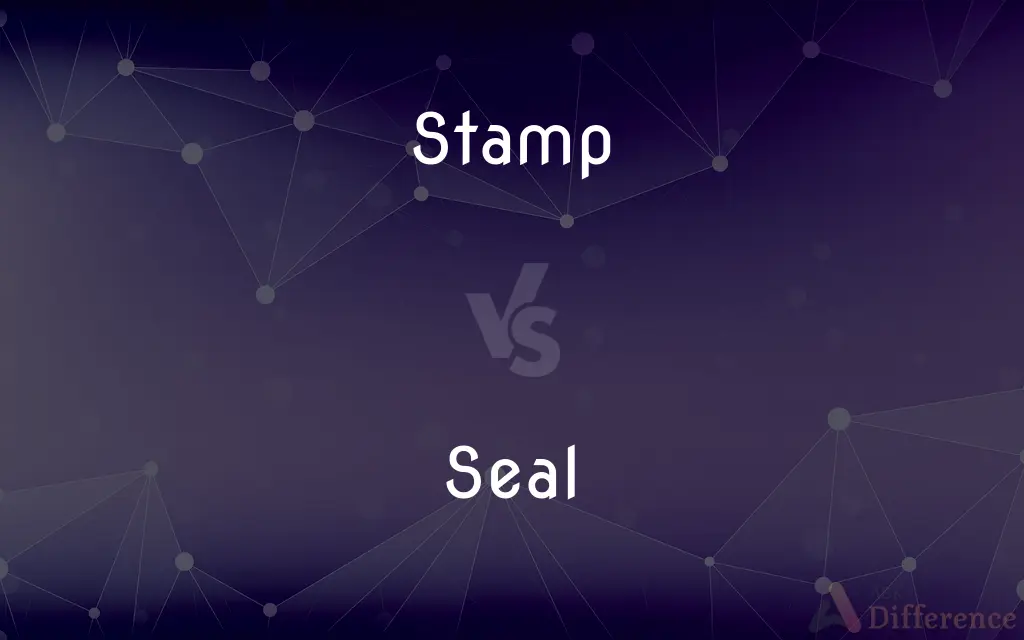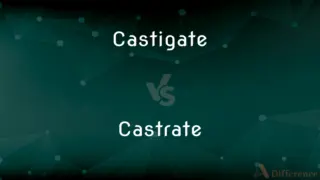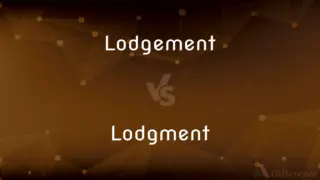Stamp vs. Seal — What's the Difference?
By Tayyaba Rehman & Urooj Arif — Updated on March 1, 2024
A stamp is a tool that imprints a design or message onto a surface, often used for decoration or marking documents. A seal is a device used to emboss or imprint a design onto a material like wax, leaving a raised impression, primarily for authentication.

Difference Between Stamp and Seal
Table of Contents
ADVERTISEMENT
Key Differences
Stamps and seals serve different purposes and have distinct historical and practical applications. Stamps are commonly used in administrative, artistic, and educational contexts. They apply ink to a surface to create a flat image or text, such as postal stamps, office date stamps, or decorative stamps used in crafting. The primary function of a stamp is to apply a repetitive design or message quickly and efficiently.
Seals, on the other hand, have a more formal and secure purpose. Historically, seals were used to authenticate documents, denote signatures before widespread literacy, and ensure the confidentiality of correspondence. Seals are made by pressing a hard object, often engraved with a unique design or coat of arms, into a softer material like wax, clay, or embossing stickers. The resulting raised impression acts as a security measure, indicating if a document has been tampered with.
Stamps are widely used for practical and decorative purposes, requiring only ink and a surface, whereas seals involve a more complex process that includes a sealing material that hardens to form a distinct impression. This impression is unique and can serve as a signature or mark of authority, making seals particularly important in legal, corporate, and ceremonial contexts.
The transition from physical to digital documentation has changed how seals are used, with digital seals and signatures increasingly replacing physical wax seals. However, physical seals still hold significant value in various cultures and legal systems, symbolizing authenticity and authority.
The choice between using a stamp or a seal depends on the intended purpose: stamps for applying quick, visible marks, and seals for adding a layer of security and authenticity to documents. Both tools reflect the importance of symbols and marks in communication, record-keeping, and art.
ADVERTISEMENT
Comparison Chart
Purpose
To mark or decorate surfaces with ink.
To authenticate, secure, and formalize documents.
Impression
Flat, ink-based image or text.
Raised, embossed design or text.
Material Used
Ink on paper, fabric, or other surfaces.
Wax, clay, or embossing materials.
Usage Context
Administrative, artistic, educational.
Legal, corporate, ceremonial.
Historical Significance
Used for communication, decoration.
Signified authority, authenticity, security.
Compare with Definitions
Stamp
A tool for imprinting images/text with ink.
She used a rubber stamp to decorate the invitations.
Seal
A device for creating raised impressions.
The notary affixed her seal to the certificate.
Stamp
Common in everyday administrative tasks.
The clerk stamped the document with today's date.
Seal
Symbolizes authenticity and authority.
The king's seal was pressed into the wax of the decree.
Stamp
Essential for postal services.
Each letter was affixed with a postage stamp.
Seal
Used for securing documents.
Confidential letters were sealed with a personal emblem.
Stamp
Versatile in art and craft.
The artist created a pattern using a handmade stamp.
Seal
Important in legal documents.
The contract was validated with the company's corporate seal.
Stamp
Easy to use and accessible.
Children enjoyed using colorful stamps for their project.
Seal
Represents tradition and formality.
The diploma was adorned with the university's official seal.
Stamp
An impression or shape formed by such an implement or device.
Seal
To affix a seal to (something) in order to prove authenticity, accuracy, or quality.
Stamp
An act of stamping the foot, paw or hoof.
The horse gave two quick stamps and rose up on its hind legs.
Seal
(transitive) To place in a sealed container.
I've sealed the documents in this envelope.
Stamp
To put a stamp on, as for postage; as, to stamp a letter; to stamp a legal document.
Seal
Wax, wafer, or other tenacious substance, set to an instrument, and impressed or stamped with a seal; as, to give a deed under hand and seal.
Till thou canst rail the seal from off my bondThou but offend'st thy lungs to speak so loud.
Stamp
The mark made by stamping; a mark imprinted; an impression.
That sacred name gives ornament and grace,And, like his stamp, makes basest metals pass.
Seal
That which seals or fastens; esp., the wax or wafer placed on a letter or other closed paper, etc., to fasten it.
Stamp
An official mark set upon things chargeable with a duty or tax to government, as evidence that the duty or tax is paid; as, the stamp on a bill of exchange.
Seal
To fasten with a seal; to attach together with a wafer, wax, or other substance causing adhesion; as, to seal a letter.
Stamp
A stamped or printed device, usually paper, issued by the government at a fixed price, and required by law to be affixed to, or stamped on, certain papers, as evidence that the government dues are paid; as, a postage stamp; a tax stamp; a receipt stamp, etc.
Seal
To affix one's seal, or a seal.
I will seal unto this bond.
Stamp
Machine consisting of a heavy bar that moves vertically for pounding or crushing ores
Seal
Fastener consisting of a resinous composition that is plastic when warm; used for sealing documents and parcels and letters
Stamp
A device incised to make an impression; used to secure a closing or to authenticate documents
Seal
Make tight; secure against leakage;
Seal the windows
Seal
Cover with varnish
Common Curiosities
Can a stamp function as a seal?
While stamps can signify approval or completion, they do not provide the same level of security or authenticity as a traditional seal.
Are seals still used today?
Yes, seals are used in legal, corporate, and ceremonial contexts to authenticate and secure documents, though digital alternatives are becoming more common.
How are digital seals different from physical seals?
Digital seals provide electronic authentication, similar to digital signatures, ensuring document security and authenticity in a digital format.
Do all countries use seals for official documents?
The use of seals varies by country and legal system, with some relying heavily on seals for document authentication, while others may use signatures or digital methods.
What is a stamp?
A stamp is a tool that applies ink to create a flat image or text on various surfaces, used for marking or decoration.
What is a seal?
A seal is a device used to emboss a raised design onto a softer material, such as wax or clay, for authentication and security.
What materials are needed to make a seal impression?
Traditional seal impressions require a sealing device and a soft material like wax or sealing stickers designed to hold the embossed design.
Why are stamps more common than seals?
Stamps are more versatile and accessible for everyday use, including administrative tasks, arts, and crafts, making them more common in daily activities.
How do you preserve a wax seal?
To preserve a wax seal, avoid exposure to heat and direct sunlight, and store documents in a cool, dry place to prevent the wax from cracking.
Can anyone create a seal?
Creating a personal seal is possible, but official seals, such as those used by notaries or corporations, often have legal requirements and registrations.
Share Your Discovery

Previous Comparison
Castigate vs. Castrate
Next Comparison
Lodgement vs. LodgmentAuthor Spotlight
Written by
Tayyaba RehmanTayyaba Rehman is a distinguished writer, currently serving as a primary contributor to askdifference.com. As a researcher in semantics and etymology, Tayyaba's passion for the complexity of languages and their distinctions has found a perfect home on the platform. Tayyaba delves into the intricacies of language, distinguishing between commonly confused words and phrases, thereby providing clarity for readers worldwide.
Co-written by
Urooj ArifUrooj is a skilled content writer at Ask Difference, known for her exceptional ability to simplify complex topics into engaging and informative content. With a passion for research and a flair for clear, concise writing, she consistently delivers articles that resonate with our diverse audience.















































